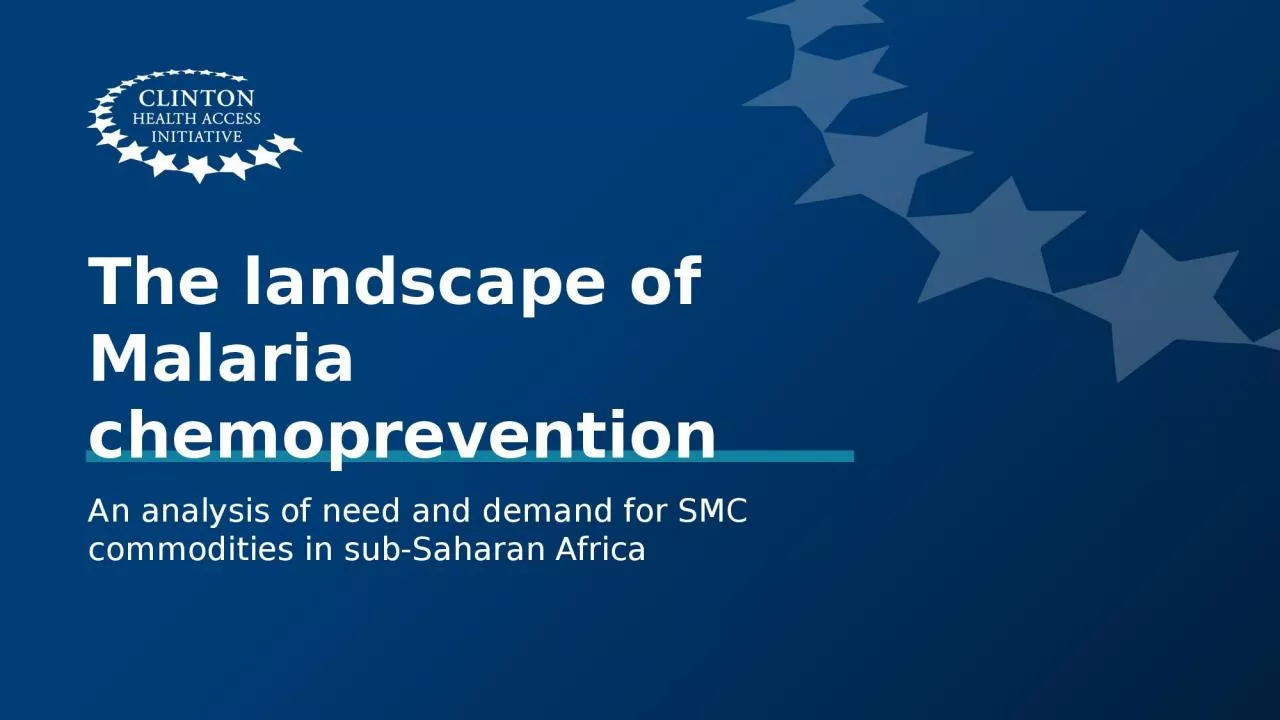

The landscape of Malaria chemoprevention This deep dive is part of the forecasting project whose objective is to combine available data on ongoing financial investments and strategic national planning for the use and expansion of malaria commodities to produce a consensus view of malaria commodit ID: 1042888
Download Presentation The PPT/PDF document "An analysis of need and demand for SMC c..." is the property of its rightful owner. Permission is granted to download and print the materials on this web site for personal, non-commercial use only, and to display it on your personal computer provided you do not modify the materials and that you retain all copyright notices contained in the materials. By downloading content from our website, you accept the terms of this agreement.
1. An analysis of need and demand for SMC commodities in sub-Saharan AfricaThe landscape of Malaria chemoprevention
2. This deep dive is part of the forecasting project whose objective is to combine available data on ongoing financial investments and strategic national planning for the use and expansion of malaria commodities to produce a consensus view of malaria commodity market trends and support identification of potential supply risks and efficient planning/resource allocation. Deep dive objectives: To outline broader context on marketplace for specified commoditiesExploration of demand side and supply side considerations and scenarios for how demand for specified product may evolve2BackgroundWhy chemoprevention: Updates to the WHO recommendations for IPTp, MDA, PMC & SMC Introduction of other preventive methods e.g malaria vaccine(s) which may affect the landscape.The deep dive discusses both PMC & SMC but focus will be on the SMC findings.
3. 3Updates to the WHO recommendations for SMC Previous recommendation (2012)New recommendation (June 2022)Geographical restrictions to Sahel subregion Removal of restrictions based on geography and SP resistance.Maximum doses stipulated: 4 monthly doses of SMC during the malaria transmission season.Removed of specifications around monthly cyclesAge: Limited to children under 5 years of age.Age: SMC use is not limited to children under 5 years of age; use shall be guided by the local area’s risk of severe disease.
4. 4MethodsAreas with rainfall seasonality ≥ 60% per the Markham’s Seasonality Index + Pf Prevalence ≥5%Regions identified as eligible for SMC based on updated WHO recommendationsPopulation estimates from SMC Alliance and IHME to project the number of children aged 3-59 months and 5-9 years in these regionsNumber of SPAQ treatmentsSMC need: SPAQ treatments to all regions that are eligibleSMC demand: SPAQ treatments to all regions that are have implemented SMC in the past, or have ongoing pilots
5. 5Potential for expansion of SMC under new WHO recommendationsSMC eligible areas under expanded WHO criteriaSMC implementing areas (2022)
6. 6The ages 3-59 months population covered with SMC could increase by up to 1.5 times per year if all regions that are eligible for SMC implement it.TAKEAWAYSSMC demand is driven by population growth in admin-2 areas already implementing SMC and gradual expansion into other eligible areas with highly seasonal malaria transmission.
7. 7Translated to SPAQ treatments, expansion to all eligible areas would double the number of treatments procured between 2021 and 2031.
8. 8Considerations for future uptake of SMCFor sustainable expansion of SMC, there needs to be; 1. Evidence of effectiveness of SPAQ in new areas2. Affordable and safe treatment options, with sufficient supply to meet market demand 3. Effective methods of distribution in age cohorts over 5 years4. Sufficient funding In the updated 2022 guidelines, WHO recommends a combination medicine for SMC that is different from the country’s first-line malaria treatment.
9. 9ConclusionsScale up of SMC in recent years has been rapid, from 14 million children treated with SMC in 2016, to 45 million in 2021.Given the sustained interest observed in SMC over recent years, we have projected continued increase in uptake of SMC, driven by expansion to eligible areas and population growth. However, it is possible that there will be a levelling off or reduction in SMC as countries move towards more targeted deployment approaches and/or have to grapple with budget constraints. SPAQ for SMC is an inexpensive interventions for commodity procurement, with program delivery being the primary cost consideration for funding. However, for SMC, use of alternate treatments may be necessary to mitigate resistance. This could have a substantial impact on program costing.Link to the deep dive: here
10. 10The malaria atlas projectIVCCTHE ENDTHANK YOU